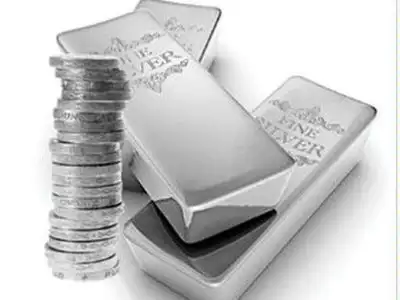
Silver, integral to India’s cultural tapestry, fosters international relations through trade and diplomacy. Its significance extends beyond borders, bridging diverse cultures and economies with shared appreciation.
Siler prize in India today is ₹ 86.50/ Gram and as comparison to yesterday Prize was ₹ 87
Today –
10 Gram = ₹ 865 , 100 Gram = ₹ 8,650
Yesterday –
10 Gram = ₹870 , 100 Gram = ₹ 8,700

Table of Contents
About Silver in India
- Ancient Heritage: Silver has been deeply ingrained in India’s cultural fabric for millennia, tracing back to the Harappan Civilization around 3000 BCE.
- Adornment and Aesthetic: Silver jewelry, adorned with intricate designs and often embedded with semi-precious stones, has been cherished by both men and women across various regions of India for its lustrous appeal.
- Spiritual Significance: In Hinduism, silver holds sacred value and is frequently used in religious ceremonies and offerings to deities, symbolizing purity and auspiciousness.
- Trade and Commerce: Historically, silver played a pivotal role in India’s trade networks, being exchanged along ancient routes like the Silk Road and maritime trade routes. Silver coins, known as ‘Rupiya’, were minted by various dynasties and rulers, serving as a medium of exchange.
- Colonial Era: During colonial times, India emerged as a significant exporter of silver to Europe and China, contributing to global trade dynamics. The introduction of the standardized ‘Rupee’ coinage by the British further emphasized silver’s monetary significance.
- Artistic Expressions: Silver has inspired artistic endeavors across India, with craftsmen showcasing their skills in crafting silverware, including utensils, tableware, and decorative items, each reflecting regional styles and motifs.
- Textile Embellishment: Zari, made of silver or silver-coated copper, is intricately woven into Indian textiles like sarees and lehengas, adding a touch of elegance and opulence to traditional attire.
- Investment and Wealth Preservation: While gold remains the primary choice for investment, silver serves as a more accessible option due to its lower cost. Silver coins and bars are popular choices for gifting during festivals and auspicious occasions, symbolizing prosperity.
- Industrial Applications: With the rise of technology and manufacturing sectors, the demand for silver in industrial applications has increased. It is used in electronics, solar energy, and healthcare, highlighting its versatility and importance in modern industries.
- Cultural Continuity: Despite evolving economic and technological landscapes, silver continues to hold cultural significance in India, perpetuating its timeless allure across generations and reinforcing its status as a symbol of purity, prosperity, and artistic expression.
About Silver
- Global Silver Production: Silver is mined and produced in various parts of the world, with major producers including countries like Mexico, Peru, China, Russia, and Australia. These nations contribute significantly to the global supply of silver, meeting industrial, investment, and jewelry demand worldwide.
- Industrial Applications: Silver’s unique properties, such as its conductivity, reflectivity, and antibacterial qualities, make it indispensable in numerous industrial applications. It is used in electronics, solar panels, medical devices, and water purification systems, among other sectors, driving global demand for the metal.
- Investment and Trading: Silver serves as an important investment asset globally, alongside gold and other precious metals. Investors purchase silver in various forms, including coins, bars, and exchange-traded funds (ETFs), as a hedge against inflation, economic uncertainty, and currency devaluation. The global silver market, encompassing trading on commodity exchanges and over-the-counter markets, plays a crucial role in price discovery and liquidity.
- Silver Consumption: Beyond industrial and investment demand, silver is widely consumed in the form of jewelry, tableware, and decorative items around the world. Its aesthetic appeal, affordability, and cultural significance make it a popular choice for adornments and gifts in many societies.
- Silver Recycling: Recycling plays a significant role in the global silver supply chain, with a substantial portion of silver production derived from recycled sources. Industrial processes, electronic waste recycling, and jewelry scrap contribute to the recycling of silver, promoting sustainability and resource efficiency.
- Price Dynamics: The price of silver is influenced by various factors, including industrial demand, investment sentiment, currency movements, and global economic conditions. Silver prices often exhibit volatility, responding to changes in supply and demand dynamics, geopolitical events, and macroeconomic indicators.
- Environmental Considerations: Silver mining and refining processes can have environmental impacts, including habitat disruption, water pollution, and carbon emissions. Sustainable mining practices and initiatives to reduce the environmental footprint of silver production are gaining importance in the global mining industry.
- Regulatory Frameworks: Regulatory frameworks governing silver mining, trading, and usage vary across countries and regions. Environmental regulations, labor standards, and taxation policies influence the operations of silver mining companies and the dynamics of the global silver market.
- Emerging Trends: Technological advancements, such as the increasing use of silver in advanced electronics, renewable energy systems, and healthcare applications, are driving new trends in the global silver market. Innovations in silver-based materials and technologies continue to expand the metal’s utility and market potential worldwide.
FAQs
Frequently Asked Questions About Silver
- What is silver?
- Silver is a chemical element with the symbol Ag and atomic number 47. It is a lustrous metal with a white, shiny appearance and excellent conductivity.
- How is silver formed?
- Silver is primarily formed through supernova nucleosynthesis, a process that occurs in the cores of massive stars during stellar explosions. It can also be found in ores such as argentite, silver sulfide, and other minerals.
- What are the uses of silver?
- Silver has numerous applications, including:
- Industrial: Electronics, solar panels, medical devices, and water purification.
- Investment: Coins, bars, and exchange-traded funds (ETFs).
- Jewelry and Adornments: Rings, necklaces, bracelets, and decorative items.
- Silverware: Tableware, utensils, and decorative pieces.
- Textiles: Zari threads used in traditional Indian textiles.
- Is silver a good investment?
- Silver is considered a popular investment asset alongside gold. It is often used as a hedge against inflation, economic instability, and currency devaluation. However, like all investments, it carries risks and its value can fluctuate.
- Where is silver mined?
- Silver is mined in various countries around the world, with major producers including Mexico, Peru, China, Russia, and Australia. It is also produced as a by-product of other metal mining operations.
- How is silver recycled?
- Silver can be recycled from various sources, including electronic waste, industrial processes, and jewelry scrap. Recycling facilities extract silver through processes such as smelting and refining, contributing to sustainability and resource conservation.
- What factors influence the price of silver?
- The price of silver is influenced by factors such as industrial demand, investment sentiment, currency fluctuations, global economic conditions, geopolitical events, and supply dynamics.
- Is silver mining environmentally friendly?
- Silver mining can have environmental impacts, including habitat disruption, water pollution, and carbon emissions. However, efforts are being made to improve sustainability through initiatives such as responsible mining practices and environmental regulations.
- Are there any health benefits associated with silver?
- Silver has antimicrobial properties and is used in healthcare settings for wound dressings, catheters, and other medical devices. However, excessive exposure to silver can be harmful, and it is not recommended for consumption beyond regulated uses.
- Where can I buy silver?
- Silver can be purchased from various sources, including bullion dealers, coin shops, jewelry stores, and online platforms. It is available in the form of coins, bars, jewelry, and other products.
Conclusion
Silver, a versatile metal, holds cultural, industrial, and investment significance globally. Its lustrous appeal adorns jewelry, while its conductivity powers electronics and fuels medical advancements. Despite environmental concerns, silver remains a coveted asset, symbolizing purity and prosperity across diverse societies and industries.




![Ellora Caves [ 600 – 1000 ] AD](https://supremebulletnews.com/wp-content/uploads/2024/06/Untitled-design-15.png)

